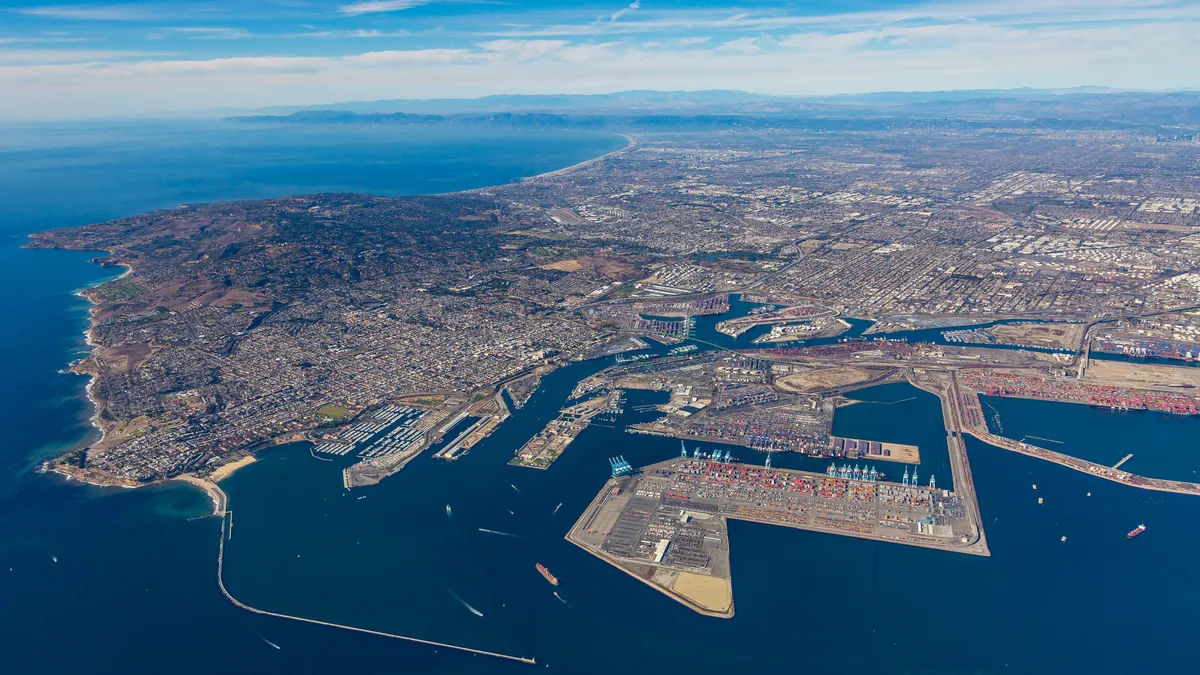Dive Brief:
- Southern California warehouses are at or near capacity, Port of Los Angeles Executive Director Gene Seroka said at a media briefing Wednesday. Loaded imports last month were up 29% over October 2019, and the port anticipates a 41% increase in volume next week, compared to the same week last year.
- Congestion at the port and surrounding warehouses has created delays in the supply chain. During the import surge, terminal dwell times doubled to five days, street dwell times waiting for warehouse space doubled to about seven days, and truck turn times are going up, Seroka said.
- In the coming weeks, the port staff will propose to the Los Angeles Board of Harbor Commissioners a monetary incentive for dual transactions, “to make sure the trucks enter the gate with a container and also leave with one” for greater efficiency at the port, Seroka said.
Dive Insight:
Imports rebounded after what Seroka called a “dismal first half of 2020,” and the deluge is overwhelming supply chain and cargo movement infrastructure around the San Pedro Bay Port Complex.
“Containers are accumulating in large numbers with fewer and fewer places to put them,” Seroka said. “It’s simply impossible for all of us to keep pace with this volume of cargo.”
Strained resources have slowed equipment returns to the port. But vessels are eager to turn back to Asia as soon as possible to shuttle containers to points of origin, where they are in “enormous demand,” Seroka said.
Container xChange’s data shows the container availability index for this week in Shanghai at 0.07, a 2020 low. Any figure below 0.5 indicates a container deficit.
“We’re at a point today where shipping line companies believe it makes more economic sense to send empty containers back to Asia rather than wait for loaded shipments with American exports,” Seroka said. Empty containers reached a record at the Port of Los Angeles of 330,180 TEU, more than double the TEUs of loaded exports.
Resolving the congestion issues plaguing the port will require greater use of real-time data and a digital strategy, Seroka said.
The port is launching a digital tool called The Reverse Signal, following its launch in September of The Signal, which gives the supply chain community a three-week view of cargo arriving into the port for planning purposes. The Reverse Signal is designed to let the trucking community know when and where they can return containers, with the goal of encouraging dual transactions. The data updates every five minutes.
Several port stakeholders have pushed for dual transactions as a way to alleviate chassis shortages. The sticking point is often a lack of advanced communication and visibility between the parties operating at or near the port. The Harbor Trucking Association has asked ocean carriers for 48 hours’ notice about which terminals need an empty container, so the fleets can book dual transactions, CEO Weston LaBar said at a press conference Monday. Several of the carriers responded, saying it’s not possible to give more than 24 hours’ notice.
“It’s got to be a cohesive strategy with warehouses, trucking companies and terminal operators,” said Ramon Ponce De Leon, president of the International Longshore and Warehouse Union’s Local 13. He pointed to issues with chassis shortages and a lack of gondolas to move bulk goods via rail.
And outside of the port area, Seroka suggested retailers could provide more visibility into their purchase order cycles to help smooth port operations. Retail procurement leaders typically know at least 90 days in advance how much merchandise they’re ordering.
“If we can get a line of sight on those orders ... imagine if we could have 90 days advanced notice on the strength of demand,” Seroka said. Three-months preparation time would allow the port and unions to position assets and labor ahead of an import surge.
“So we’re not bunching up at one time and we can get the ships on schedule back to Asia,” Seroka said.
The port anticipates an easing of the volume surge in December and expects cargo activity to pick up again leading into the Lunar New Year in February.















